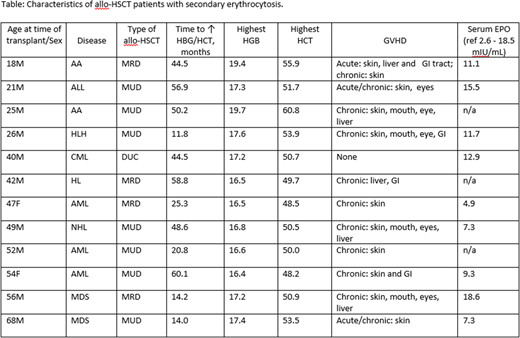Abstract
Background: Erythrocytosis is a condition of increased red blood cell mass, as reflected by laboratory findings of elevated hemoglobin (HGB) and hematocrit (HCT). Erythrocytosis is classified into primary (polycythemia) and secondary, depending on its etiology. Secondary polycythemia most commonly develops in the setting of chronic hypoxemia which triggers increased production of erythropoietin by the kidneys. We have observed several patients in our hematology clinic who were long-term survivors after allogeneic hematopoietic stem cell transplant (allo-HSCT), and subsequently developederythrocytosisduring their follow up without obvious secondary causes. On literature review we found two single-institutional studies with estimated incidence of this unexpected complication reported as 0.45 and 1.1% respectively. Majority of described patients in the literature were young males with aplastic anemia (AA).
Methods: To establish the incidence of post-transplant erythrocytosis in long termsurvivors of allo-HSCT, we conducted a retrospective single site chart review study using theWVUdatabase.All patients above age of 18 at the time of transplantation regardless the initial diagnosis that lead to transplantation and type of allo-HSCT were included. Patients with disease relapse and follow up less than 12 months were excluded. We also excluded patients with underlying conditions that are commonly associated with secondary erythrocytosis. Following definition of polycythemia or erythrocytosis was used: a) HCT >48% in women or >49% in men and/or HGB >16.0 g/dL in women or >16.5 g/dL in men (as extrapolated from WVO 2016 PV criteria); b) HGB/HCT elevation consistent on at least two measurements 3 months apart.
Results: We identified 133 eligible patients for final analysis. Among them, 12 (9.0%) developed erythrocytosis in amedian time from initial allo-HSCT 44.5 months (11.8-60.1). Peripheral blood Jak2V617F mutation was tested in 8/12 patients - negativeinall. Serum erythropoietin (EPO) level was tested for 9/12 patients and found to be not suppressed in all cases to the level of HGB/HCT, median 11.1 mU/ml (4.9-18.6). All patients were non-smokers and 11/12 patients had different degree of GVHD requiring immunosuppressive therapy. The highest levels of HGB/HCT were observed in two patients with aplastic anemia and one of them required periodic therapeutic phlebotomies. In rest of the patients erythrocytosis was relatively mild but persistent. Details on our findings are presented in a table below.
Conclusions: Acquired secondary erythrocytosis is not uncommon in long-term survivors of allo-HSCT, estimated at 9.0% in our patient cohort. The exact mechanisms of erythrocytosis in this setting are unknown but probably related to dysregulated EPO production and response.
Craig:Celgene: Research Funding; Novartis: Research Funding; Actinium Pharmaceuticals: Research Funding.
Author notes
Asterisk with author names denotes non-ASH members.


This feature is available to Subscribers Only
Sign In or Create an Account Close Modal